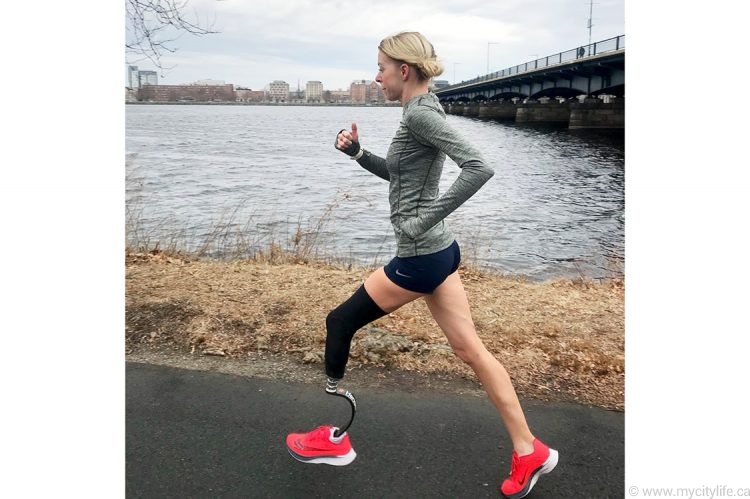Adrianne Haslet: True Grit
Adrianne Haslet’s dream was to be the next Ginger Rogers — until she lost part of her leg as a result of the Boston Marathon bombing.
Life can change on a dime. Imagine you are out for a leisurely lunch on a gorgeous spring day, feeling cheerful as you stroll by gardens full of blooming red tulips, yellow narcissus and pale pink magnolia trees.
And then, without any warning at all, a bomb explodes in your midst, and suddenly your whole world changes — forever.
Adrianne Haslet, a premier ballroom dancer who was ranked third in the world in her dance discipline, had finished her lunch. Curious to see what all the noise was about on that warm spring day, she headed toward what sounded like celebratory cheering.
It was April 15, 2013, and the runners of the prestigious Boston Marathon — the oldest annual marathon in the world — were nearing the finish line of their 26.2-mile contest.
“I didn’t even know that the marathon was on,” Haslet says. “I heard a lot of cheering on Boylston Street, so I went over to see what was going on.”
Shortly after Haslet arrived there was a huge blast, which was quickly followed by another. “When the first blast went off, I put my head in my arms and covered my ears. I knew it wasn’t a transformer that had gone off,” she says. “I knew that there was going to be another blast. With the way that it shook the ground, I knew that it was definitely an attack.”
The second blast, which covered the area in smoke, was a mere two feet away. When Haslet looked down and saw that her left foot was gone, she went into full panic mode. Rolling over on her belly, she dragged herself on her elbows and forearms through a nearby doorway, where a man grabbed her by her shoulders and dragged her inside. Serendipitously, an off-duty doctor was nearby and acted quickly, applying a tourniquet on Haslet’s wound, saving the top half of her leg — and quite possibly saving her life — as she was losing a lot of blood.
“I was conscious the whole time,” Haslet says. “I remember the firemen putting me on a gurney and taking me to the hospital. People were screaming in the triage area — it was [organized] Living life on life’s terms chaos. I was screaming and screaming, and the doctors and nurses told me that I was going to make it. I was so cold and I was in so much pain — I was shaking.”
Her surgery was extensive, lasting close to 14 hours. Haslet remembers thinking before she was operated on that she would never see her parents again; a person doesn’t just get blown up by a terrorist and survive. But when she woke up, her parents, who lived on the other side of the country, in Seattle, were there.
“When I woke up from the surgery, I could see underneath the bedsheet that my left leg was shorter than the other. It was awful,” says Haslet. “But my parents were there and that helped.”
The reality of what life was like pre-April 15, 2013, and what life was going to be like moving forward was an unimaginable thing to process. Haslet’s dream from the time she was little was not only to dance like Ginger Rogers, but also to be Ginger Rogers. A fulltime ballroom dancer (she had started dancing when she was in elementary school), Haslet was enjoying life, dancing 10 to 12 hours a day. “Dance allowed me to express myself in an artistic way; I was living the dream. It was a great career — and a pretty good life,” she says.
Determination and perseverance are ingrained traits in Haslet — attributes that are powerful, validating and sustaining. “I had led such an active life before, so my thought processes kicked in pretty quickly. I could either eat Cheetos and sit in an easy chair for the rest of my life, or I could dance again. It was an either-or choice. There was no grey area. I didn’t want to sit on my butt for the rest of my life,” she says.
Somewhere between Day 4 and Day 6 after the bombing, broadcast journalist Anderson Cooper arrived at Haslet’s room, invited there by her mom. With her winning smile, which is instantly infectious, and a zest for life that transcends the normal layers of discipline, Haslet told Cooper that she was going to learn to dance again. “If you do that,” Cooper said, “will you teach me?”
“That was pretty motivating — it gave me something to look forward to,” Haslet says with a laugh. (Haslet detailed her first year of recovery in a documentary that she did with Cooper titled The Survivor Diaries, which can be viewed at www.dailymotion.com.)
With a lion-heartedness that refuses to look at defeat as an option, Haslet went on to tell Cooper that not only was she going to dance again, but she was also going to take up running — in fact, she was going to run a marathon, she told him — even though she had no perspective whatsoever on what it was like to run even a mile.
It was a comical scene as Haslet’s dad stood in the background waving his arms, trying to get his daughter’s attention. “I used to forge notes to get out of gym class in high school,” Haslet says, laughing. “But I was so completely taken by Anderson that I forgot that we were recording.”
Haslet, who calls herself a goal digger — not a gold digger, she stresses — knew that sharing her goals was an important step in her recovery. It would give her the sustaining support from others to keep going on the days when she was having trouble believing in herself.
Those early days, the weeks and months of working her way back to a place that was tenable, were unimaginably hard for Haslet. After spending a mere nine days in the hospital, followed by a week at Spaulding Rehabilitation, Haslet was sent home. “I didn’t get a chance to talk to a lot of the other survivors,” she says. “I was released before a lot of people got to rehab, so I didn’t get that sense of community. The day I was released, I cried and cried; I was so upset. I didn’t know how to deal with stranger danger, or my PTSD [post-traumatic stress disorder], and I hadn’t found a therapist at that point, either.”
The second day after Haslet returned home, she and her mom went out to the grocery store and for a walk, with Haslet’s mom pushing her in a wheelchair. Not knowing the streets of Boston very well, they unintentionally ended up right at the bombing site — where the memorial for those affected by the bombings was. Surrounded by people, Haslet was overcome with severe stranger danger; she was literally paralyzed. “I thought everyone was a terrorist because I didn’t know what one looked like. As much as the love was there, I was completely taken aback — frozen and terrified,” she says.
Grit — the determination to go on in the face of what seems like insurmountable odds — defines Haslet, and step by literal step, she began to adapt to her new way of life. After being fitted with a prosthetic leg, Haslet doggedly began to walk. Not quite a year after the bombing, in March 2014, Hugh Herr, the director of Biomechatronics at MIT’s Media Lab (Haslet had met him at Spaulding Rehabilitation), built Haslet a bionic nuanced limb that allowed her to take the stage and dance at a TED Talk. “It was an incredible thing to be a part of,” Haslet says. “The ability to move my body in that way … I never thought that I would be able to do that again.”
Of course, it is virtually impossible for Haslet to equate how dancing felt before she lost her lower left leg and how dancing feels with a prosthetic. The natural flow, the way her muscles moved — there is just no way to compare, because the feeling, the overall experience, is like night and day.
But something remarkable happened to Haslet on her road to recovery — something both ironic and life-changing. But this time, it was a change for the good. Haslet was approached by a woman in the grocery store, who asked her when she was going to run the Boston Marathon. “I had hoped that people had forgotten about that,” Haslet says with a laugh.
But Haslet’s family and friends encouraged her and told her that they believed she could do it. So Haslet thought she would give it a try, so she could tell everyone she’d done her best. “I got out a running blade that I had stowed in the back of my closet; I put it on and went for a run around the block, falling twice along the way. It was insanely hard — probably the hardest thing I had ever done — and I’d done some really hard things,” she says. “But I kept trying — I ran the next day and the next day after that. I started to track my distance and found out that I was running 10 miles at a time.”
With no reference as to how hard running a marathon would be, Haslet announced in 2016 that she was going to run a marathon — the Boston Marathon. It is quite the feat to commit to running a marathon — especially when running has never been your discipline. But to commit to running a marathon 36 months after losing part of your leg to a terrorist bombing, in the very location where the bombing had happened, is an emotionally complex commitment. Certainly, there would be a deep well of both unconscious as well as conscious fear around running with and being among huge crowds of people at an event that had literally changed hundreds of people’s lives. In total, the bombing took three people’s lives, injured 264 people and resulted in 17 people losing limbs.
Thank you Adrianne for being Boston Strong. Bombs and terrorists can’t beat us. We carry on, we finish the race — Barack Obama
“The starter gun went off, and I started running — some people would call it jogging; some people would call it walking,” Haslet says with a laugh. “I had a big setback at Mile 6 (a marathon is 26.2 miles); my prosthetic was giving me issues. Some of my friends told me that I had tried, that it was good enough, that I could quit. But I kept going. I came in dead last [it took Haslet 10 hours and 44 minutes to complete the marathon], but for a recovering perfectionist that is pretty amazing. It was so hard — but it was so fun.”
Shortly after she finished the race, Haslet got a tweet from the then – President of the United States, Barack Obama: “Thank you Adrianne for being Boston Strong. Bombs and terrorists can’t beat us. We carry on, we finish the race.”
“Running the Boston Marathon was one of the best days of my life,” Haslet says. “There was huge support from both family and friends, and in particular, the Boston Strong community — who encouraged me right from the beginning to try running the marathon.”
That being said, Haslet is vocal about how hard her fight to attain her new normal has been. Her PTSD, while being managed, is certainly a lying-in-wait factor in her life. “It never goes away — at least for me,” Haslet says. “I do believe that going to therapy — learning coping mechanisms, such as breathing exercises, mediation and learning what you can and cannot handle — makes it a lot easier. But it never goes away. You just find ways to deal with it.”
Like everyone else, Haslet is not happy about the COVID-19 pandemic and all of its restrictions, but nevertheless, she is elated that there will be no fireworks this year for the Fourth of July celebrations. “I am ridiculously happy there are no fireworks because of my PTSD — and I am sure that I am not alone,” she says.
When the conversation turns to the bombers — who were brothers — Haslet makes no secret of the fact that she is a strong proponent of the death penalty. “I stand my ground for what I believe in,” she says. “During the trial, the prison warden where the younger of the bomber brothers was imprisoned testified that he’d heard through the prison grapevine that the bombers planned to blow up New York, following the Boston bombing. So there is zero chance that if the younger brother lives, he won’t do the same thing again; he wants to kill more people. We are talking about the safety of the United States. This bomber wants to do more damage, create more carnage.”
With an attitude that is defined by positivity, Haslet has embraced a new approach to life — one that involves prioritizing her bucket list. No. 1 on her list? To win the Boston Marathon — a goal that unfortunately has been stymied this year with the cancellation of the marathon due to COVID-19. Her second priority is to get more coverage around procuring running legs for amputees. (Running legs are currently not covered by insurance in the United States.) To that end, in 2019 Haslet founded the Adrianne Strong Foundation, with the purpose of raising funds to purchase running legs for those who can’t afford them. “So many amputees can hardly afford regular legs, so if they have money, that is where it goes. People change sizes, so sometimes they need to get a new prosthetic,” Haslet says. “On average, a running leg can cost between US$15,000 and US$17,000.”
Among her many awards, Haslet has received the 2013 MedStar NRH Gala Victory Award (Washington, D.C.) and was honoured alongside her first responders at the 2013 Schwartz Center Gala in Boston. In 2013, she was named one of Cosmo’s Most Powerful Women, and in 2014 she received the On Cue Tribute Award.
Now, Haslet’s public speaking career is front and centre, as she travels all over the globe — to places like Kenya, Ecuador, Canada and across the United States, speaking to corporations, hospitals and schools about new normals and overcoming adversity. “I tell people how hard it has been and how hard it is, and the fact that it sucks,” Haslet says. “It is important to me to give opportunities to other people. That is what I want my legacy to be — that I have given opportunities for other people to speak about their therapy; I want to help them find their new normal. I want to give people the opportunity to run or to have the opportunities that they dream of.”
When a traumatic event happens in a person’s life, one that completely uproots them and is seismically life-changing, things are often referred to as “the before” and “the after” of the situation. For Haslet, her “the life before” was centred on the material things that made her happy. And now? Well, now Haslet’s happiness is defined by how happy she is in the quiet moments. “We don’t know how happy we are until we see how happy we can be; how happy we are at the end of the day, when we put our head on the pillow. I would say that the silver lining in all of this is, I have been able to extrapolate and get to know who I am on a deeper level. I’ve gotten to know my heart and how to utilize my coping mechanisms. Going through therapy has helped me get to know myself, to know who I am and what I stand for.”
A true champion is defined not by the challenges that the person has experienced along the way, but rather, how they use those challenges as powerful tools to make it to the finish line.
And in that sense, no matter what else happens, Haslet is a champion. With all of the trauma that she has personally experienced — physically, emotionally and spiritually — there are many who would make excuses for either why they couldn’t move forward or why they couldn’t even think of trying.
Haslet, on the other hand, focuses not on what defined her before, or what the experience and impact of surviving a bomb has done to her. Instead, she looks at what options she has now and what passions drive her; and from there, she has created a champion attitude for herself — one that refuses to allow the acts of terrorists to delineate how she is going to live her life moving forward.
“The only goal is to have more good days than bad days,” Haslet says. “And I am achieving that.”


















































































